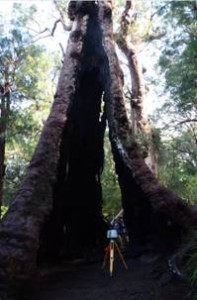The Latrobe Valley is dominated by some of Australia’s most carbon intensive coalmines and power stations. Source: The Conversation, author Jason Alexandra, Adjunct Fellow Charles Darwin University
Covering much of the surrounding hills are timber plantations, which store tonnes of carbon.
Plantations can be used to soak up emissions – except the current rules don’t officially recognise this. Intensive plantations don’t count as carbon sinks under Australia’s carbon farming rules.
The boom that led to the creation of almost a million hectares of new plantation timber died with the global financial crisis – but with a bit of smart thinking these could be put to use as carbon farms, rather than being allowed to die off and returned to pasture.
The see-sawing fortunes of Australian forestry have largely been driven by government policy.
The 1990s saw major policy reforms, which spawned protests (including log trucks blockading the national parliament) and ultimately resulted in a widespread expansion of timber plantations.
The area of eucalyptus plantations grew from almost nothing in 1998 to about 1 million hectares by 2008, spurred by a massive influx of finance encouraged by the Managed Investments Act (1998), which turned plantations into tax-effective investments.
But then came the global financial crisis, which saw Managed Investment Scheme (MIS) companies like Timbercorp and Great Southern Plantations go bust. Shareholders and investors lost out, but the plantations themselves were in the ground.
Since then, plantation ownership has been consolidated into the hands of a few dominant players such as NewForests, which acquired more than 700,000 ha, and Global Forest Partners (more than 150,000 ha).
Some MIS plantations were poorly sited, in terms of climate and soils, used inappropriate species, or suffered pest or disease problems.
Some have been written off, bulldozed and returned to pasture. Many more are likely to be.
Current estimates suggest that a third of the eucalyptus plantations are uneconomic with harvesting unlikely, another third will probably be harvested but are unlikely to be replanted. The rest will form Australia’s future hardwood estate.
In this sense it has been a massive and expensive experiment. This story shows the power of financial incentives, but reflects the problem of using tax inducements to fund an industry.
For investors, tax deductions became the primary goal, rather than the quality of the investment. The plantations’ boom and bust, with its focus on using fast money for fast-growing eucalypts, mostly for pulpwood, has obscured other important opportunities.
First, it shifted the focus away from the opportunities of integrating forestry into farming systems.
Second, the reputation of Australian forestry and forestry investments has almost certainly suffered.
Third, it may have blinded us to the potential of using Australia’s rich diversity of tree species for other purposes.
Australia’s genetic gifts to the world include trees that grow prolifically in poor soils, can withstand fire and drought, store carbon, and produce hard, strong, richly coloured timbers.
Already planted across millions of hectares throughout the world, Australia’s eucalypts, acacias and casuarinas offer a genetic treasure trove for carbon farming.
With much to learn about Australia’s diverse and productive flora – including how to farm it for carbon – it seems perverse that investment in Australian forestry research and education is now declining.
Carbon markets and emerging technologies could fundamentally alter the way we conceive of trees as crops.
With a million hectares of eucalyptus plantation approaching maturity, there is almost certainly an active search for commercial markets for the standing timber – as wood fibre, for bioenergy fuel, or for non-wood products.
Nonetheless, large areas are likely to be reconverted to pasture, resulting in less carbon being stored in these landscapes.
But there’s another, even simpler option for what to do with these plantations.
Perhaps it is time to reconsider whether to credit the carbon captured by these trees, given that their plantings were sponsored by our taxes.
Changes to the carbon farming rules might make these and other multi-use plantations more viable.
The Australian Forest Industry estimates that Australia’s Kyoto-compliant forestry plantations (those established on cleared land since 1990) offset about 4.5% of Australia’s total emissions, but these are not credited under Australia’s Carbon Farming Initiative.
There are no approved CFI methodologies for plantations that sequester carbon and produce commercial timbers, but if there were, multipurpose plantations could form a key plank of Australia’s Direct Action carbon abatement policy.
In addition to carbon, there is potential for plantings that deliver economic development and ecological benefits in terms of restoring landscapes. But new models of plantations are needed, supported with different policy setting that drive their development.
Any large-scale bio-energy or carbon plantings in the future need to heed the lessons from Australia’s plantation boom and bust.
In emerging carbon-constrained economies, how we define resources in rural landscapes, including carbon credits, will literally shape our future.






